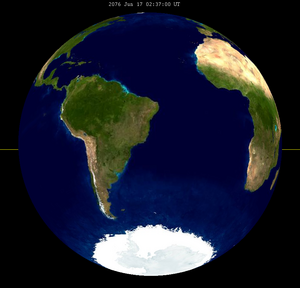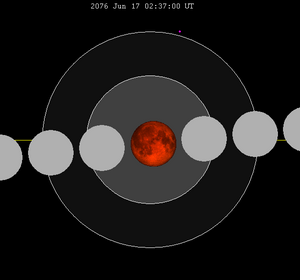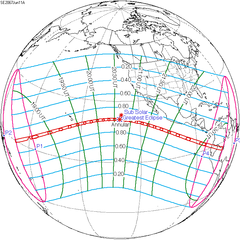A total lunar eclipse will occur at the Moon’s descending node of orbit on Wednesday, June 17, 2076,[1] with an umbral magnitude of 1.7959. It will be a central lunar eclipse, in which part of the Moon will pass through the center of the Earth's shadow. A lunar eclipse occurs when the Moon moves into the Earth's shadow, causing the Moon to be darkened. A total lunar eclipse occurs when the Moon's near side entirely passes into the Earth's umbral shadow. Unlike a solar eclipse, which can only be viewed from a relatively small area of the world, a lunar eclipse may be viewed from anywhere on the night side of Earth. A total lunar eclipse can last up to nearly two hours, while a total solar eclipse lasts only a few minutes at any given place, because the Moon's shadow is smaller. Occurring about 1.9 days before perigee (on June 18, 2076, at 20:40 UTC), the Moon's apparent diameter will be larger.[2]
While the visual effect of a total eclipse is variable, the Moon may be stained a deep orange or red color at maximum eclipse. With a gamma value of only −0.0452 and an umbral eclipse magnitude of 1.7959, this is the second greatest eclipse in Saros series 131 as well as the largest and darkest lunar eclipse between June 26, 2029 and June 28, 2094. Overall, it will be the third largest and darkest lunar eclipse of the 21st century. While it will have similar values to the lunar eclipse of July 16, 2000, totality will not last over 106 minutes due to the moon's relatively large apparent size as seen from Earth and greater speed in its elliptical orbit.
NGC 6401 will be occulted by the Moon during the eclipse over Eastern North America, Cuba, the Atlantic Ocean, Southeast Europe and the northern half of Africa.[3]: 160
Visibility
The eclipse will be completely visible over South America, west Africa, and Antarctica, seen rising over North America and the eastern Pacific Ocean and setting over Europe, west and south Asia, and central and east Africa.[4]
 
|
Eclipse details
Shown below is a table displaying details about this particular solar eclipse. It describes various parameters pertaining to this eclipse.[5]
| Parameter | Value |
|---|---|
| Penumbral Magnitude | 2.75698 |
| Umbral Magnitude | 1.79585 |
| Gamma | −0.04518 |
| Sun Right Ascension | 05h46m08.2s |
| Sun Declination | +23°23'27.6" |
| Sun Semi-Diameter | 15'44.6" |
| Sun Equatorial Horizontal Parallax | 08.7" |
| Moon Right Ascension | 17h46m06.8s |
| Moon Declination | -23°26'09.4" |
| Moon Semi-Diameter | 16'22.8" |
| Moon Equatorial Horizontal Parallax | 1°00'07.0" |
| ΔT | 104.8 s |
Eclipse season
This eclipse is part of an eclipse season, a period, roughly every six months, when eclipses occur. Only two (or occasionally three) eclipse seasons occur each year, and each season lasts about 35 days and repeats just short of six months (173 days) later; thus two full eclipse seasons always occur each year. Either two or three eclipses happen each eclipse season. In the sequence below, each eclipse is separated by a fortnight. The first and last eclipse in this sequence is separated by one synodic month.
| June 1 Ascending node (new moon) |
June 17 Descending node (full moon) |
July 1 Ascending node (new moon) |
|---|---|---|
 |
 |

|
| Partial solar eclipse Solar Saros 119 |
Total lunar eclipse Lunar Saros 131 |
Partial solar eclipse Solar Saros 157 |
Related eclipses
Eclipses in 2076
- A total solar eclipse on January 6.
- A partial solar eclipse on June 1.
- A total lunar eclipse on June 17.
- A partial solar eclipse on July 1.
- A partial solar eclipse on November 26.
- A total lunar eclipse on December 10.
Metonic
- Preceded by: Lunar eclipse of August 28, 2072
- Followed by: Lunar eclipse of April 4, 2080
Tzolkinex
- Preceded by: Lunar eclipse of May 6, 2069
- Followed by: Lunar eclipse of July 29, 2083
Half-Saros
- Preceded by: Solar eclipse of June 11, 2067
- Followed by: Solar eclipse of June 22, 2085
Tritos
- Preceded by: Lunar eclipse of July 17, 2065
- Followed by: Lunar eclipse of May 17, 2087
Lunar Saros 131
- Preceded by: Lunar eclipse of June 6, 2058
- Followed by: Lunar eclipse of June 28, 2094
Inex
- Preceded by: Lunar eclipse of July 7, 2047
- Followed by: Lunar eclipse of May 28, 2105
Triad
- Preceded by: Lunar eclipse of August 16, 1989
- Followed by: Lunar eclipse of April 19, 2163
Lunar eclipses of 2074–2078
This eclipse is a member of a semester series. An eclipse in a semester series of lunar eclipses repeats approximately every 177 days and 4 hours (a semester) at alternating nodes of the Moon's orbit.[6]
The penumbral lunar eclipses on February 11, 2074 and August 7, 2074 occur in the previous lunar year eclipse set, and the penumbral lunar eclipses on April 27, 2078 and October 21, 2078 occur in the next lunar year eclipse set.
| Lunar eclipse series sets from 2074 to 2078 | ||||||||
|---|---|---|---|---|---|---|---|---|
| Descending node | Ascending node | |||||||
| Saros | Date Viewing |
Type Chart |
Gamma | Saros | Date Viewing |
Type Chart |
Gamma | |
| 111 | 2074 Jul 08 |
Penumbral |
1.4456 | 116 | 2075 Jan 02 |
Penumbral |
−1.1642 | |
| 121 | 2075 Jun 28 |
Partial |
0.6897 | 126 | 2075 Dec 22 |
Partial |
−0.4945 | |
| 131 | 2076 Jun 17
|
Total
|
−0.0452 | 136 | 2076 Dec 10 |
Total |
0.2102 | |
| 141 | 2077 Jun 06 |
Partial |
−0.8387 | 146 | 2077 Nov 29 |
Partial |
0.8854 | |
| 156 | 2078 Nov 19 |
Penumbral |
1.5147 | |||||
Saros 131
This eclipse is a part of Saros series 131, repeating every 18 years, 11 days, and containing 72 events. The series started with a penumbral lunar eclipse on May 10, 1427. It contains partial eclipses from July 25, 1553 through March 22, 1932; total eclipses from April 2, 1950 through September 3, 2202; and a second set of partial eclipses from September 13, 2220 through April 9, 2563. The series ends at member 72 as a penumbral eclipse on July 7, 2707.
The longest duration of totality will be produced by member 38 at 100 minutes, 36 seconds on June 28, 2094. All eclipses in this series occur at the Moon’s descending node of orbit.[7]
| Greatest | First | |||
|---|---|---|---|---|
 The greatest eclipse of the series will occur on 2094 Jun 28, lasting 100 minutes, 36 seconds.[8] |
Penumbral | Partial | Total | Central |
| 1427 May 10 |
1553 Jul 25 |
1950 Apr 02
|
2022 May 16
| |
| Last | ||||
| Central | Total | Partial | Penumbral | |
| 2148 Jul 31 |
2202 Sep 03 |
2563 Apr 09 |
2707 Jul 07 | |
Eclipses are tabulated in three columns; every third eclipse in the same column is one exeligmos apart, so they all cast shadows over approximately the same parts of the Earth.
| Series members 22–43 occur between 1801 and 2200: | |||||
|---|---|---|---|---|---|
| 22 | 23 | 24 | |||
| 1806 Jan 05 | 1824 Jan 16 | 1842 Jan 26 | |||
| 25 | 26 | 27 | |||
| 1860 Feb 07 | 1878 Feb 17 | 1896 Feb 28 | |||
| 28 | 29 | 30 | |||
| 1914 Mar 12 | 1932 Mar 22 | 1950 Apr 02 | |||

|

|

|

|

|

|
| 31 | 32 | 33 | |||
| 1968 Apr 13 | 1986 Apr 24 | 2004 May 04 | |||

|

|

|

|

|

|
| 34 | 35 | 36 | |||
| 2022 May 16 | 2040 May 26 | 2058 Jun 06 | |||

|

|

|

|

|

|
| 37 | 38 | 39 | |||
| 2076 Jun 17 | 2094 Jun 28 | 2112 Jul 09 | |||

|

|

|

|
||
| 40 | 41 | 42 | |||
| 2130 Jul 21 | 2148 Jul 31 | 2166 Aug 11 | |||
| 43 | |||||
| 2184 Aug 21 | |||||
Tritos series
This eclipse is a part of a tritos cycle, repeating at alternating nodes every 135 synodic months (≈ 3986.63 days, or 11 years minus 1 month). Their appearance and longitude are irregular due to a lack of synchronization with the anomalistic month (period of perigee), but groupings of 3 tritos cycles (≈ 33 years minus 3 months) come close (≈ 434.044 anomalistic months), so eclipses are similar in these groupings.
| Series members between 1801 and 2200 | |||||||||
|---|---|---|---|---|---|---|---|---|---|
| 1803 Aug 03 (Saros 106) |
1814 Jul 02 (Saros 107) |
1825 Jun 01 (Saros 108) |
1836 May 01 (Saros 109) |
1847 Mar 31 (Saros 110) | |||||
| 1858 Feb 27 (Saros 111) |
1869 Jan 28 (Saros 112) |
1879 Dec 28 (Saros 113) |
1890 Nov 26 (Saros 114) |
1901 Oct 27 (Saros 115) | |||||

|

| ||||||||
| 1912 Sep 26 (Saros 116) |
1923 Aug 26 (Saros 117) |
1934 Jul 26 (Saros 118) |
1945 Jun 25 (Saros 119) |
1956 May 24 (Saros 120) | |||||

|

|

|

|

|

|

|

|

|

|
| 1967 Apr 24 (Saros 121) |
1978 Mar 24 (Saros 122) |
1989 Feb 20 (Saros 123) |
2000 Jan 21 (Saros 124) |
2010 Dec 21 (Saros 125) | |||||

|

|

|

|

|

|

|

|

|

|
| 2021 Nov 19 (Saros 126) |
2032 Oct 18 (Saros 127) |
2043 Sep 19 (Saros 128) |
2054 Aug 18 (Saros 129) |
2065 Jul 17 (Saros 130) | |||||

|

|

|

|

|

|

|

|

|

|
| 2076 Jun 17 (Saros 131) |
2087 May 17 (Saros 132) |
2098 Apr 15 (Saros 133) |
2109 Mar 17 (Saros 134) |
2120 Feb 14 (Saros 135) | |||||

|

|

|

|

|

|
||||
| 2131 Jan 13 (Saros 136) |
2141 Dec 13 (Saros 137) |
2152 Nov 12 (Saros 138) |
2163 Oct 12 (Saros 139) |
2174 Sep 11 (Saros 140) | |||||
| 2185 Aug 11 (Saros 141) |
2196 Jul 10 (Saros 142) | ||||||||
Half-Saros cycle
A lunar eclipse will be preceded and followed by solar eclipses by 9 years and 5.5 days (a half saros).[9] This lunar eclipse is related to two annular solar eclipses of Solar Saros 138.
| June 11, 2067 | June 22, 2085 |
|---|---|

|

|
See also
Notes
- ^ "June 16–17, 2076 Total Lunar Eclipse (Blood Moon)". timeanddate. Retrieved 14 December 2024.
- ^ "Moon Distances for London, United Kingdom, England". timeanddate. Retrieved 14 December 2024.
- ^ Meeus, Jan (2002). "Occultations of deep-sky objects during a total lunar eclipse". More Mathematical Astronomy Morsels (PDF). pp. 157–162. ISBN 0943396743.
- ^ "Total Lunar Eclipse of 2076 Jun 17" (PDF). NASA. Retrieved 14 December 2024.
- ^ "Total Lunar Eclipse of 2076 Jun 17". EclipseWise.com. Retrieved 14 December 2024.
- ^ van Gent, R.H. "Solar- and Lunar-Eclipse Predictions from Antiquity to the Present". A Catalogue of Eclipse Cycles. Utrecht University. Retrieved 6 October 2018.
- ^ "NASA - Catalog of Lunar Eclipses of Saros 131". eclipse.gsfc.nasa.gov.
- ^ Listing of Eclipses of series 131
- ^ Mathematical Astronomy Morsels, Jean Meeus, p.110, Chapter 18, The half-saros
External links
- 2076 Jun 17 chart Eclipse Predictions by Fred Espenak, NASA/GSFC











